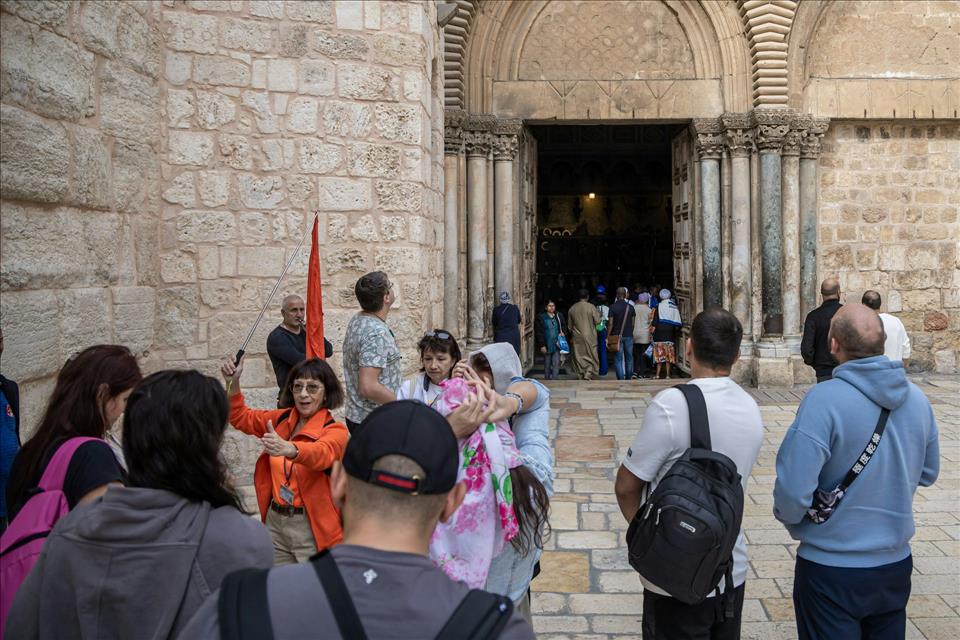
War In Gaza Has Plunged Israel's Tourism Industry Into A Crisis It Will Struggle To Recover From
Apparently, a chance encounter with the Patriarch of Jerusalem had led to him accessing the Church of the Holy Sepulchre for the Holy Fire Ceremony, Orthodox Christianity's most significant event of the year.
This scene was being repeated by innumerable people in countless places throughout the city. The details change, but the significance of their authentic, spiritual experience carried through them all.
The significance of the“Holy Land” cannot be underestimated for the faithful. For more than 2,000 years it has been one of the world's most significant pilgrimage sites. In modern times this has provided the foundation for a lucrative tourism industry worth a reported US$8.46 billion (£6.73 bn) for Israel and US$1 billion for Palestine in 2019.
But since October tourists have not been able to access the region at all. Most major airlines have suspended travel to Israel over concerns of safety, and governments around the world have advised their citizens against travelling there. Standard travel insurance packages also no longer include cover for people travelling to the region.
In 1936, Franz Krausz created this stylised view of Jerusalem's Old City for Zionist groups to encourage Jewish immigration to the Holy Land. Islandstock / Alamy Stock Photo
Beyond economic development, tourism plays a significant political role in the region. The Zionist movement, which led to the creation of Israel in 1948, recognised early that tourism was an excellent tool to foster global connections and encourage immigration to support the Zionist settlement of Palestine.
This has only increased and expanded over the decades. More recently, it manifests in an expansive industry of pro-Israel evangelical Christian tours and free birthright trips offered to young people of the Jewish diaspora.
For the first half of 2023, I lived in Jerusalem researching the political significance of tourism across the region. I interviewed people working in, advocating for, and being affected by tourism activities. It was a turbulent time as violence has escalated, yet pilgrims and tourists still flocked to the region as the global tourism industry continued to recover following the pandemic.
Having now watched Christmas, Ramadan, Passover and Easter pass, I find myself reflecting on how much has changed in just one year. After seven months of intense violence in the region, the destruction of Gaza, the very visible and ongoing suffering of Palestinians, and an International Court of Justice ruling that Israel's actions in Gaza could amount to genocide, it cannot possibly return to business as usual.
Grinding to a haltTour companies in Palestine and Israel are used to waxing and waning violence resulting in uncertain income due to cancelled trips. They normally operate with a reserve of capital to ensure that they can survive these tough months.
But several of my interviewees revealed that these reserves have been completely depleted throughout the pandemic. Many companies are now in a very precarious position without their safety net as the industry grinds to a halt.
Some have reacted quickly, offering tours to diplomats and journalists – the only international visitors remaining in the region. But this can do little to staunch the bleeding industry and many, if not most, of these companies will no longer exist when tourism is finally able to return to the region.
Worshippers gathered in the Church of the Holy Sepulchre, Jerusalem, for the Holy Fire ceremony. Abir Sultan / EPA
Israel's most steadfast allies are also beginning to waver in their support for the assault on Gaza. Mass student protests across infamously pro-Israel American universities, calls for boycott, divestment and sanctions, and an uncensorable social media advocacy and solidarity movement , make the future outlook for Israel's tourism industry bleak, both as a generator of revenue and a Zionist political tool.
There will eventually exist a tourist audience in the future. But the receptiveness of this audience to a Zionist narrative is questionable.
International supporters of Israel are becoming aware of the violent settler-colonial aspect of Zionism . Many are being swayed to support Palestine along with vast swaths of the global population who had never spared a thought for Israel or Palestine before October. And the average tourist or pilgrim is now aware of the propagandist language and framing of narrative that previously they would have accepted at face value and never questioned.
The global surge of support for Palestinians may transition to these people wishing to visit and meet them to show solidarity and witness the suffering and oppression with their own eyes. Israel has effectively destroyed one of its historically most effective tools in the continuation of its settler project by destroying Gaza for the world to see.

Legal Disclaimer:
MENAFN provides the
information “as is” without warranty of any kind. We do not accept
any responsibility or liability for the accuracy, content, images,
videos, licenses, completeness, legality, or reliability of the information
contained in this article. If you have any complaints or copyright
issues related to this article, kindly contact the provider above.


















Comments
No comment